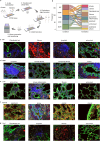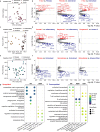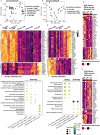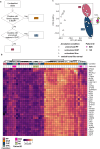Spatially resolved gene expression profiles of fibrosing interstitial lung diseases
- PMID: 39488596
- PMCID: PMC11531500
- DOI: 10.1038/s41598-024-77469-5
Spatially resolved gene expression profiles of fibrosing interstitial lung diseases
Abstract
Fibrosing interstitial lung diseases (ILDs) encompass a diverse range of scarring disorders that lead to progressive lung failure. Previous gene expression profiling studies focused on idiopathic pulmonary fibrosis (IPF) and bulk tissue samples. We employed digital spatial profiling to gain new insights into the spatial resolution of gene expression across distinct lung microenvironments (LMEs) in IPF, chronic hypersensitivity pneumonitis (CHP) and non-specific interstitial pneumonia (NSIP). We identified differentially expressed genes between LMEs within each condition, and across histologically similar regions between conditions. Uninvolved regions in IPF and CHP were distinct from normal controls, and displayed potential therapeutic targets. Hallmark LMEs of each condition retained distinct gene signatures, but these could not be reproduced in matched lung tissue samples. Based on these profiles and unsupervised clustering, we grouped previously unclassified ILD cases into NSIP or CHP. Overall, our work uniquely dissects gene expression profiles between LMEs within and across different types of fibrosing ILDs.
Keywords: Digital spatial profiling; Gene expression; Interstitial lung disease; Lung microenvironment; Spatial transcriptomics.
© 2024. The Author(s).
Conflict of interest statement
The authors declare no competing interests.
Figures





References
-
- American Thoracic Society/European Respiratory Society International Multidisciplinary Consensus Classification of the Idiopathic Interstitial Pneumonias. Am J Respir Crit Care Med 165, 277–304 (2002).
-
- Ley, B., Collard, H. R. & King, T. E. Clinical course and prediction of survival in idiopathic pulmonary fibrosis. Am. J. Respir. Crit. Care Med. 183, 431–440 (2011). - PubMed
-
- Flaherty, K. R. et al. Idiopathic interstitial pneumonia: what is the effect of a multidisciplinary approach to diagnosis?. Am. J. Respir. Crit. Care Med. 170, 904–910 (2004). - PubMed
MeSH terms
Grants and funding
LinkOut - more resources
Full Text Sources
Medical
Molecular Biology Databases

